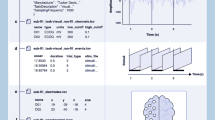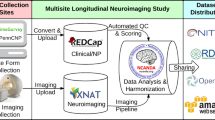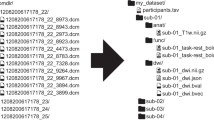Abstract
We present a modular, high performance, open-source database system that incorporates popular neuroimaging database features with novel peer-to-peer sharing, and a simple installation. An increasing number of imaging centers have created a massive amount of neuroimaging data since fMRI became popular more than 20 years ago, with much of that data unshared. The Neuroinformatics Database (NiDB) provides a stable platform to store and manipulate neuroimaging data and addresses several of the impediments to data sharing presented by the INCF Task Force on Neuroimaging Datasharing, including 1) motivation to share data, 2) technical issues, and 3) standards development. NiDB solves these problems by 1) minimizing PHI use, providing a cost effective simple locally stored platform, 2) storing and associating all data (including genome) with a subject and creating a peer-to-peer sharing model, and 3) defining a sample, normalized definition of a data storage structure that is used in NiDB. NiDB not only simplifies the local storage and analysis of neuroimaging data, but also enables simple sharing of raw data and analysis methods, which may encourage further sharing.



Similar content being viewed by others
References
Cox, R. W. (1996). AFNI: software for analysis and visualization of functional magnetic resonance neuroimages. Computers and Biomedical Research, 29(3), 162–173.
Das, S., et al. (2011). LORIS: a web-based data management system for multi-center studies. Frontiers in Neuroinformatics, 5, 37.
Frackowiak, R. S. J. (1997). Human brain function (Vol. xiii, p. 528). San Diego: Academic.
Gadde, S., et al. (2012). XCEDE: an extensible schema for biomedical data. Neuroinformatics, 10(1), 19–32.
Hähn, D., et al., (2012). Neuroimaging in the browser using the X toolkit, in neuroinformatics. Munich, Germany.
Hall, D., et al. (2012). Sharing heterogeneous data: the national database for autism research. Neuroinformatics, 10(4), 331–339.
Jack, C. R., Jr., et al. (2008). The Alzheimer’s Disease Neuroimaging Initiative (ADNI): MRI methods. Journal of Magnetic Resonance Imaging, 27(4), 685–691.
Jenkinson, M., et al. (2002). Improved optimization for the robust and accurate linear registration and motion correction of brain images. NeuroImage, 17(2), 825–841.
Jenkinson, M., et al. (2012). Fsl. NeuroImage, 62(2), 782–790.
Keator, D. B., et al. (2008). A national human neuroimaging collaboratory enabled by the Biomedical Informatics Research Network (BIRN). IEEE Transactions on Information Technology in Biomedicine, 12(2), 162–172.
Marcus, D.S., Olsen, T., Ramaratnam, M., & Buckner, R.L. (2005). XNAT: A software framework for managing neuroimaging laboratory data. in organization for human brain mapping annual meeting. Toronto.
Marcus, D. S., et al. (2007). The extensible neuroimaging archive toolkit: an informatics platform for managing, exploring, and sharing neuroimaging data. Neuroinformatics, 5(1), 11–34.
McDonald, M. (2005). Analysis of the September 15, 2005 voter fraud report submitted to the New Jersey Attorney General. New York: NYU School of Law.
Mueller, S. G., et al. (2005). Ways toward an early diagnosis in Alzheimer’s disease: the Alzheimer’s Disease Neuroimaging Initiative (ADNI). Alzheimer’s & Dementia, 1(1), 55–66.
Poline, J. B., et al. (2012). Data sharing in neuroimaging research. Frontiers in Neuroinformatics, 6, 9.
Purcell, S., et al. (2007). PLINK: a tool set for whole-genome association and population-based linkage analyses. American Journal of Human Genetics, 81(3), 559–575.
Scott, A., et al. (2011). COINS: an innovative informatics and neuroimaging tool suite built for large heterogeneous datasets. Frontiers in Neuroinformatics, 5, 33.
Zeilinger, G. (2013). dcm4chee. Available from: http://www.dcm4che.org.
Acknowledgments
Features and ideas for the Neuroinformatics Database were conceived by many individuals over the course of its development. In this way, the entire staff of the Olin Neuropsychiatry Research Center contributed to its development. Development of NiDB was supported by the National Institutes of Health (NIH) from the following grants: R37-MH43775 (NIMH), R01-AA016599 (NIAAA), RC1-AA019036-01 (NIAAA), P50-AA12870-11 (NIAAA), R01-MH077945 (NIMH), R01-MH080956-01 (NIMH), R01-MH081969 (NIMH), R01-MH082022 (NIMH), R03-DA027893 (NHLBI), R01-EB006841 (NIH/NIBIB), R44-MH075481-03A2 (NIMH), R01-AA015615-01 (NIAAA), R01-DA020709 (NIDA), RC1-MH089257 (NIH/NIMH), R01-MH074797-01 (NIMH).
Author information
Authors and Affiliations
Corresponding author
Rights and permissions
About this article
Cite this article
Book, G.A., Anderson, B.M., Stevens, M.C. et al. Neuroinformatics Database (NiDB) – A Modular, Portable Database for the Storage, Analysis, and Sharing of Neuroimaging Data. Neuroinform 11, 495–505 (2013). https://doi.org/10.1007/s12021-013-9194-1
Published:
Issue Date:
DOI: https://doi.org/10.1007/s12021-013-9194-1




